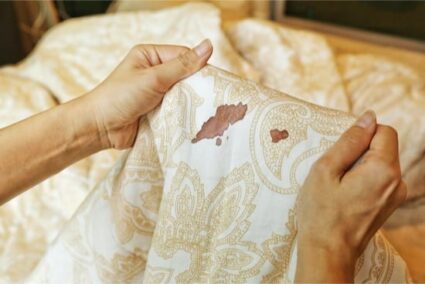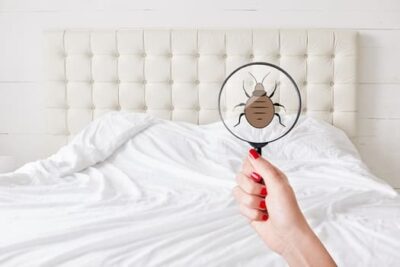If you’ve found unexplained blood stains on your bedsheets or pillows, you could have bed bugs. Blood spots on the bed are one of the most characteristic signs of an infestation.
Bed bug bites can bleed for some time after the bug has finished feeding. Blood spots can also appear when you inadvertently squash a bed bug by rolling over in the night. Bed bugs also leave fecal spots, which are made of digested blood. They’re small, flat, and dark brown.
We’ll look at why bed bugs leave blood stains in your bed sheets and pillows. We’ll also discuss how long it takes bed bugs to digest blood, and whether they have any blood of their own. Finally, we’ll explain why you might find blood spots if you don’t have bed bugs.
Do Bed Bugs Leave Marks?
Bed bugs are many people’s worst nightmare. Just reading about them is enough to make your skin crawl. However, most people don’t even realize their homes have bed bugs until the infestation is quite large.
This is because bed bugs are sneaky. They’ve evolved to avoid humans at all costs while we’re awake and moving around. They can fit into tiny gaps, and only come out while we’re asleep.
However, bed bugs do leave marks. There are two main types: blood spots and fecal spots.
Bed Bug Blood Spots on Bed Sheets and Pillows
One of the most obvious signs of a bed bug infestation is finding blood stains on your sheets, comforter, and pillow. There are three main reasons why bed bugs cause blood stains:
- Bed bug bites bleed. When bed bugs bite you, they inject an anticoagulant. This stops your blood from clotting. When the bug has finished feeding, the bites can continue to bleed for some time.
- Bed bugs have a hollow tubelike mouthpart, called a proboscis, which they use to suck up blood. After a meal, blood can sometimes drip from the proboscis as the bug makes its way back to its hiding place.
- If you roll over in the night, you might squash a bed bug without realizing it. Squashed bed bug stains will leave blotches of blood, if the bug has recently fed. If it hasn’t, you might see a yellowish-brown smear of bed bug organs instead.
Fecal Spots on Bed Sheets and Pillows
Bed bug fecal spotting, also known as poop, is very distinctive.
Although it’s made of digested blood, it isn’t red. When blood is digested, it darkens in color considerably. Bed bug poop spots usually look dark brown or black.
Fecal spots are small, round and flat. They look like ink spots from marker pens. They may be slightly raised if the poop is on an impermeable surface, such as varnished wood. However, they’re usually found along the edges of the mattress, where bed bugs like to hide.
If you find any fresh spots, they’ll smear red when you touch them. As they age, they will dry, and be very hard to remove.
How Long Does Blood Stay in a Bed Bug?
Bed bugs are flat-looking when they’re unfed. However, when a bed bug consumes a blood meal, it becomes engorged. The abdomen elongates and swells up to fit as much blood as possible.
If you squash a recently-fed, engorged bed bug, it’ll leave quite a substantial blood stain. As it slowly digests its meal, however, there will be less blood to come out.
It’s a common misconception that squashed bed bugs will always bleed. It’s possible to squash an unfed bed bug and see no blood at all. You may see the bug’s internal organs, which are a yellowish color.
Bed bugs don’t stay engorged for very long after feeding. They begin the digestion process straight away.
It takes roughly two to five days for a bed bug to digest its meal fully. This will depend on how much blood it took. Younger bed bugs typically digest their meals faster, as they’re smaller, and consume less blood at each feeding.
What Color Is Bed Bug Blood?
Bed bugs don’t have any blood of their own. This is because insects don’t produce blood in the same way that humans do.
According to the Annual Review of Entomology, insects instead have a fluid called hemolymph. This is similar to blood in a lot of ways.

Hemolymph helps to transport nutrients, such as proteins and sugars, to the body’s cells. It also clots when the insect gets injured.
However, because it doesn’t contain any red blood cells, it’s not red. Instead, it’s bluish-green when oxygenated. This is because it contains hemocyanin, which is a kind of copper-based protein. When unoxygenated, it simply looks grey.
You probably won’t be able to see the bed bug’s hemolymph when you squash one, because there’s so little of it. Instead, you’ll most likely see your undigested blood that the bug has drunk.
Blood Stains on Sheets But No Signs of Bed Bugs
Unexplained blood spots on the bedsheets are a classic sign of bed bugs.
However, it’s common for people to insist that they can’t possibly have bed bugs. They’ve never seen any bugs running around in their bed, so how could that be the case?
Well, bed bugs are small, sneaky and hard to see. Just because you haven’t seen any with your own eyes, that’s no guarantee that there are none.
How Do I Find Bed Bugs in My Home?
Bed bugs are not likely to walk past you in broad daylight. On the contrary, they usually only come out when you’re asleep.
During the day, they hide in tiny crevices around the home. Their favorite spots are the mattress, the box spring, and grooves in the headboard.
You’re more likely to see fecal spotting than the bugs themselves. Look for small, black ink-spot stains on your bedsheets and mattress.
Also, keep eyes peeled for shed bed bug casings. Bed bugs shed their exoskeletons occasionally, and leave them behind. They look like small, translucent insects, but they don’t move.
To make sure that there are no bed bugs in your home, we’d recommend scheduling an inspection with an exterminator. This usually costs between $50 and $600. The price will vary depending on:
- Where you live
- The pest control company’s rates
- The size of your home
- Whether you require the use of bed bug sniffer dogs.
Other Causes of Blood Spots on Sheets (Not Bed Bugs)
If you’ve received the all-clear from the exterminator, you’re probably feeling pretty relieved. However, now you have to figure out what else could be causing the blood stains.
There could be various reasons that you’re bleeding in the night. For example:
- Nosebleeds (epistaxis). If the stains are near your pillowcase, this could be the reason. Night-time nosebleeds are particularly likely in winter, and when your home’s humidity is too low.
- Small cuts. It’s quite common to injure yourself in your sleep accidentally. This may be more likely if you wear jewelry to bed. Very small cuts may even heal overnight. This means that you won’t notice them the next day.
- Pimples and spots. Pimples can burst in the night when you roll over. You may have some on your back where you can’t easily see them.
- Colds and illness. If you’ve recently had a bad cold, sinus or chest infection, you may be coughing up blood in your sleep.
- Pet fleas. If you have pets, check for fleas. Fleas prefer dogs and cats, but they can bite humans. Flea bites can bleed just like bed bug bites can.
The stains may not be blood at all, but something else. If you bring food or drinks into the bedroom, for example, you could have spilled something on your bed.
If you’re concerned about any aspect of your health, it’s always wise to consult a doctor.
What Should I Do If I Have Bed Bugs?
It might take you a while to notice the signs of bed bugs in your home. This is especially true if the infestation is still small. The fewer bed bugs you have, the harder it will be to spot them.
However, if you do find signs of bed bugs, don’t panic. Bed bugs can’t spread diseases, and their bites won’t cause severe damage. They may be unpleasant, but you aren’t in danger.
It is imperative, though, to tackle the problem as soon as you can. Bed bugs can reproduce and multiply very quickly. If you sit on your hands, the infestation will only get worse.
The best and fastest way of getting rid of bed bugs is to hire a professional pest control service. They’ll use extreme heat treatment to kill all bugs and eggs in your home. They may also combine this with insecticides, to be on the safe side.
You can buy insecticides yourself, but bear in mind that bed bugs can hide in the smallest of gaps. They’re notorious for hiding in tiny crevices to escape the poison. This is why bed bug bombs and foggers often don’t work.
If you live in a rented property, contact the landlord straight away to inform them of the problem. Depending on the terms of your lease, and your state laws, they may be required to hire an exterminator for you.

